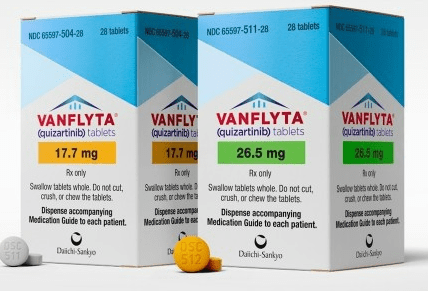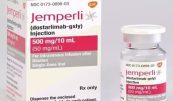Quizartinib is approved by the FDA for newly diagnosed acute myeloid leukemia
August 2023: The treatment of adult patients with newly diagnosed acute myeloid leukaemia (AML) that is FLT3 internal tandem duplication (ITD)-positive, as detected by an FDA-approved test, with standard cytarabine and anthracycline induction and cytarabine consolidation, as well as as maintenance monotherapy following consolidation chemotherapy, has been approved by the Food and Drug Administration.
LeukoStrat CDx FLT3 Mutation Assay was additionally given FDA approval as a Vanflyta companion diagnostic.
In QuANTUM-First (NCT02668653), a randomised, double-blind, placebo-controlled trial involving 539 patients with newly diagnosed FLT3-ITD positive AML, the effectiveness of quizartinib in combination with chemotherapy was assessed. A clinical trial assay was used to establish the FLT3-ITD status prospectively, and the companion diagnostic LeukoStrat CDx FLT3 Mutation Assay was used to confirm it after the fact.
According to the initial assignment, patients were randomised (1:1) to receive quizartinib (n = 268) or a placebo (n = 271) with induction, consolidation, and maintenance monotherapy. At the start of post-consolidation therapy, there was no re-randomization. After hematopoietic stem cell transplantation (HSCT) recovery, patients who underwent HSCT started maintenance therapy.
Overall survival (OS), calculated from the randomization date until death from any cause, served as the primary efficacy outcome measure. After at least 24 months had passed since the final patient was randomly assigned, the major analysis was carried out. In the trial, the quizartinib arm showed a statistically significant increase in OS [hazard ratio (HR) 0.78; 95% CI: 0.62, 0.98; 2 sided p=0.0324]. With a median duration of 38.6 months (95% CI: 21.9, NE), the quizartinib arm’s CR rate was 55% (95% CI: 48.7, 60.9), and the placebo group’s CR rate was 55% (95% CI: 49.2, 61.4) with a median duration of 12.4 months (95% CI: 8.8, 22.7).
Following allogeneic HSCT, quizartinib is not recommended as maintenance monotherapy. Quiartinib has not been shown to increase OS in this situation.
QT prolongation, torsades de pointes, and cardiac arrest are all mentioned in the boxed warning for quizartinib. Only the Vanflyta REMS, a restricted programme under a Risk Evaluation and Mitigation Strategy (REMS), offers quizartinib. For a comprehensive list of side effects, consult the prescribed information.
The recommended quizartinib dose is as follows:
- Induction: 35.4 mg orally once daily on Days 8-21 of “7 + 3” (cytarabine [100 or 200 mg/m2/day] on Days 1 to 7 plus daunorubicin [60 mg/m2/day] or idarubicin [12 mg/m2/day] on Days 1 to 3) and on Days 8-21 or 6-19 of an optional second induction (“7 + 3” or “5 + 2” [5 days cytarabine plus 2 days daunorubicin or idarubicin], respectively),
- b) Consolidation: 35.4 mg orally once daily on Days 6-19 of high‑dose cytarabine (1.5 to 3 g/m2 every 12 hours on Days 1, 3 and 5) for up to 4 cycles, and
- c) Maintenance: 26.5 mg orally once daily on Days 1 to 14 and 53 mg once daily, thereafter, for up to thirty-six 28-day cycles.
View full prescribing information for Vanflyta
Dr. Nishant Mittal is a highly accomplished researcher with over 13 years of experience in the fields of cardiovascular biology and cancer research. His career is marked by significant contributions to stem cell biology, developmental biology, and innovative research techniques.
Research Highlights
Dr. Mittal's research has focused on several key areas:
1) Cardiovascular Development and Regeneration: He studied coronary vessel development and regeneration using zebrafish models1.
2) Cancer Biology: At Dartmouth College, he developed zebrafish models for studying tumor heterogeneity and clonal evolution in pancreatic cancer.
3) Developmental Biology: His doctoral work at Keio University involved identifying and characterizing medaka fish mutants with cardiovascular defects.
4) Stem Cell Research: He investigated the effects of folic acid on mouse embryonic stem cells and worked on cryopreservation techniques for hematopoietic stem cells.
Publications and Presentations
Dr. Mittal has authored several peer-reviewed publications in reputable journals such as Scientific Reports, Cardiovascular Research, and Disease Models & Mechanisms1. He has also presented his research at numerous international conferences, including the Stanford-Weill Cornell Cardiovascular Research Symposium and the Weinstein Cardiovascular Development Conference.
In summary, Dr. Nishant Mittal is a dedicated and accomplished researcher with a strong track record in cardiovascular and cancer biology, demonstrating expertise in various model systems and a commitment to advancing scientific knowledge through innovative research approaches.
- Comments Closed
- August 14th, 2023






acute myeloid leukemia targeted drugs, AML maintenance therapy, FLT3 inhibitor therapy, FLT3-ITD AML treatment, QuANTUM-First trial results, quizartinib FDA approval, tyrosine kinase inhibitor leukemia, Vanflyta newly diagnosed AML
CancerFax is the most trusted online platform dedicated to connecting individuals facing advanced-stage cancer with groundbreaking cell therapies.
Send your medical reports and get a free analysis.
🌟 Join us in the fight against cancer! 🌟
Привет,
CancerFax — это самая надежная онлайн-платформа, призванная предоставить людям, столкнувшимся с раком на поздних стадиях, доступ к революционным клеточным методам лечения.
Отправьте свои медицинские заключения и получите бесплатный анализ.
🌟 Присоединяйтесь к нам в борьбе с раком! 🌟